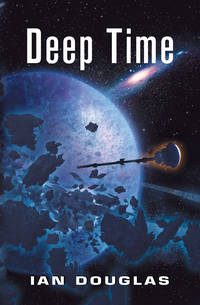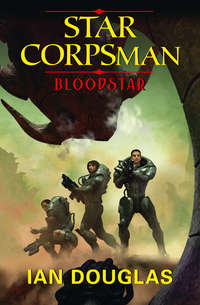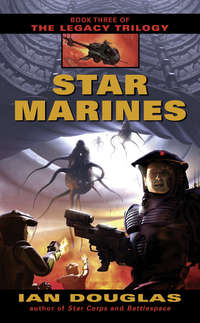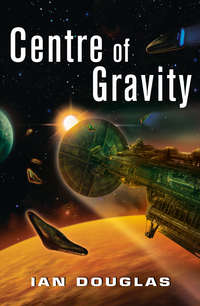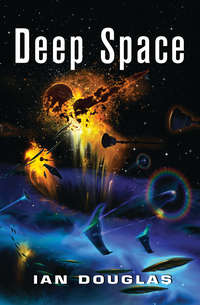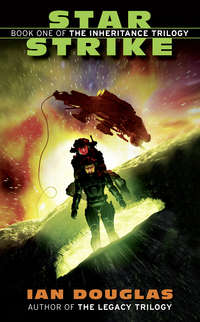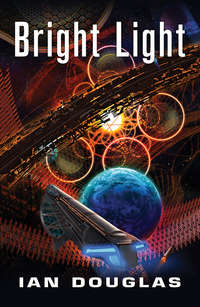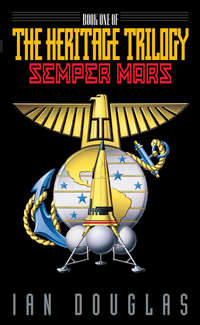
Полная версия
The Complete Inheritance Trilogy: Star Strike, Galactic Corps, Semper Human
A hypothetical planet swung into view, a sharp-edged crescent bowed away from the star, attended by a clutter of sickle-shaped moons. A swarm of dark gray and metallic slivers materialized out of emptiness and scattered across the system. Other planets appeared in the distance, along with the gleaming, wedding-band hoop of a stargate.
“First in are AI scouts, to show us the terrain. We also need to know if there’s a stargate in the target system. The scouts will find out if there is a Xul presence in the system, and map it out so we’re not going in blind.”
Obedient to his lecture, a Xul station revealed itself, menacing and black, positioned to guard the stargate. A swarm of new objects entered the scene, dull-black ovoids, descending toward the Xul structure in waves. Pinpoints of white light flickered and strobed against the surface in a silent representation of space combat.
“The Marines go in hot, wearing marauder armor and accompanied by highly specialized penetrator AIs,” Alexander went on. “Details depend on what the scouts turn up, of course, but the idea will be to insert a Marine raiding party into the Xul, grab as much information as we can, and blow the thing to hell.”
On cue, the camera point of view pulled back sharply, just as the Xul base in the scene, in complete silence, detonated—a searing, fast-expanding ball of white light that briefly outshone the brilliant local sun.
“Very pretty,” Devereaux said as the display faded into darkness once more. The noumenal scene flowed and shifted once more, becoming a more conventional virtual encounter space. “But just what would be the point?”
They now appeared to be seated around the perimeter of a sunken conversation pit three meters across, the representation of the Galaxy as seen from above spiraled about itself at their feet. Here, the individual icons all expanded into images of people, though their electronic secretaries and EAs remained visible only as tiny, darting icons of yellow light orbiting their human masters. The walls and ceiling of the room appeared lost in darkness.
“The point, Madam Devereaux, is to avoid being put on the defensive again. We were on the defensive in 2314. You know what happened.”
“Yes,” General Samuels said. “We beat them.”
“At a terrible cost, sir. Earth’s population in 2314 was … what?” Alexander pulled the data down from the Net. “Fifteen point seven billion people. Four billion died within the space of a few hours during the Xul bombardment. Four billion. Exact numbers were never available, given the chaos of the next few decades, but an estimated one to two billion more froze during the Endless Winter, or starved to death, or died of disease or internal electronics failure or just plain despair.”
“We know our history, General,” Devereaux said.
“Then you should know that the human race came within a hair’s breadth of becoming extinct. Over a third of the human race died, murdered by one Xul huntership. One! We were lucky to be able to destroy it. And if General Garroway hadn’t backtracked the Intruder through the Sirius Stargate to Night’s Edge and found a way to take out the base there, we wouldn’t be sitting here now discussing it!”
“And you know, General,” Devereaux said, “that the current political situation may preclude a major operation such as you seem to be suggesting. The Monists and the Starborn both are threatening to side with the Islamic Theocracy. If they do, the Commonwealth will fall.” She spread her hands. “If that happens, how are we supposed to defend ourselves if the Xul do come?”
“I submit, Madam Devereaux, that the Human species right now has more to worry about than the exact nature of God. If we do not take a stand, an active stand, against the Xul threat, if we don’t deal with it now, while we have a chance of doing so, then none of the rest matters. We’ll be settling the question of God’s nature by meeting Him face to face!”
“He does have a point, Marie,” another delegate in the circle said. He wore the uniform and the corona of a Fleet admiral, and the alphanumerics that popped up when Alexander looked at him identified him as Admiral Joseph Mason. As he spoke, the light brightened around him, drawing the eye. “We can’t ignore what’s happened out there.”
“Five hundred light-years, Admiral. It’s so far away.”
“It’s a very short step for the Xul, Marie. We’ve survived so far only because we’ve been lost within … what? Ten million stars, or so. Even the Xul can’t pay close attention to every one. But we know the Xul. We know what they did to the Builders. And to the An. And probably to some ungodly number of other civilizations and species scattered across the Galaxy over the past half million years or so. If they locate Sol and the other worlds of human space, they will do the same to us.”
The light brightened around another delegate. “And I concur, Madam Devereaux.” The speaker was a civilian, his noumenal presentation wearing the plain white robes of a Starborn Neognostic.
“You do, Ari?” Devereaux said, surprised. “I’d have thought you would be solidly opposed to this kind of … of interstellar adventurism.”
“I may be a Starbom,” Arimalen Daley said, inclining his head, “but I’m not stupid. Lieutenant General Alexander is right. We need to be careful in setting our priorities. I believe even our Theocrat friends would agree that there are times when religious or philosophical differences must be set aside for the sake of simple survival.”
Alexander was startled by Daley’s statement, but pleased. He had little patience with religion, and tended to see it as a means of denying or avoiding responsibility. Daley’s response was … refreshing.
He opened a private window in his mind, accessed an epedia link, and downloaded a brief background on the Starborn, just to make sure he hadn’t missed anything. No … he’d remembered correctly. The Starborn had been around for two or three centuries, but had arisen out of several earlier belief systems centered on The Revelation. For them, all intelligence was One … and that included even the Xul. They opposed all war in general, and most especially war based on a clash between opposing faiths. Within the Commonwealth Senate, they’d been the most vocal of the opponents of the military action against the Islamist Theocracy, for just that reason.
Alexander wondered why Daley had sided with him.
For himself, Alexander had no patience whatsoever with religion of any type. Beginning in the twentieth century, Humankind had been wracked by religious mania of the most divisive and destructive sort. World War III had been brought on by Islamic fundamentalism, but other sects and. religions demanding rigid boundaries and unquestioning obedience to what was imagined to be God’s will had added their share of terror, insanity, and blood to the chaos of the late twentieth and early twenty-first centuries. And then had come the discoveries on Mars, of buried cities and the Builders, of the mummified bodies of anatomically modern humans beneath the desiccated sands of Cydonia and Chryse.
Science fiction and the more sensationalist writers of pop-science had long speculated that extraterrestrials had created humans, but now there was proof. The Builders had tinkered with the genetics of Homo erectus in order to create a new species—Homo sapiens. It had always been assumed that if such proof was ever uncovered, it would once and for all end the tyranny and the comfort of religion. If God was a spaceman, there scarcely was need for His church. Religion would die.
Surprisingly, the opposite had happened. Though the older, traditional faiths had been badly shaken, the discoveries on Mars and elsewhere, far from destroying religion, had before long fostered new sects, religions, cults, and philosophies by the dozens, by the hundreds, some of them bizarre in the extreme. Throughout the first half of the new millennium, new faiths had spawned and vied and warred with one another, some accepting the vanished Builders or even the still-extant An or N’mah as gods, creators of Humankind, if not the cosmos. Others—in particular the stricter, more fundamentalist branches of Christianity and Islam—had adhered even more closely to the original texts, and condemned the nonhumans as demons.
Things had stabilized somewhat over the past few centuries. The attack on Earth had killed so many, had so terribly wounded civilization as a whole, that few religions, old or new, could deal with it, save in apocalyptic terms. And when Earth had, after all, survived, when Humankind began to rebuild and the expected second Xul attack had not materialized, many of the more extreme and strident of the sects had at last faded away.
There remained, however, some thousands of religions … but for the most part they fell into one of two major branches of organized spirituality, defined by their attitude toward the Xul. The Transcendents, who represented most of the older faiths plus a number of newer religions emphasizing the nature of the Divine as separate and distinct from Humankind, either ignored the Xul entirely, or associated them with the Devil, enemies of both Man and God.
The Emanists embraced religions and philosophies emphasizing that god arose from within Man, as a metasentient emanation arising from the minds of all humans, or even of all intelligence everywhere in the universe. For them, the Xul were a part of the Divine … or, at the least, His instrument for bringing about the evolution of Humankind. For most Emanists, the key to surviving the Xul was to follow the lead of the An on Ishtar—keep a low profile, roll with the punches, abjure pride and any technological activity that might attract Xul notice. The hope was that, like the Biblical Angel of Death, the Xul would “pass over” humanity once more, as it had before in both recent and ancient history.
While not as widespread as the Transcendents, Emanist religions were popular with large segments of the population on Earth, especially with the Antitechnics and the various Neoprimitive and Back-to-Earth parties. Neognostics like Daley even advocated a complete renunciation of all activities off the surface of the Earth, especially now that the ice was retreating once more.
That was why Alexander—and Devereaux too, evidently—were surprised at his position.
As Alexander closed the e-pedia window, he realized Daley was still speaking, and that he was looking at him as he did so. “Whatever the tenets of my faith might be,” the Neognostic was saying, “Humankind cannot evolve, cannot grow to meet its potential, and can never contribute to the idea we know as God if we as a species become extinct. So long as we remained beneath Xul notice, survival and growth both were possible. But now?” He spread his hands. “I dislike the idea. My whole being rebels against the very idea of war. But … if there is to be war, better it be out there, five hundred light-years away, than here among the worlds of Man.”
“Good God,” General Samuels said in the silence that followed this speech. “I thought it was nuts including a Paxist on the Advisory Council, Ari.” The Paxists included those who believed in peace-at-any-price. “But you’re okay!”
“The Paxists,” Devereaux said sternly, “were invited because they represent the views of a large minority of the Commonwealth population. Very well. General Alexander, thank you for your presentation. The Council will retire now to its private noumenon and vote the question.”
And the Council was gone, leaving Alexander alone in the imaginal room.
If the reaction to Daley’s speech was any indication, though, he would need to begin preparations.
The Marines would be going to war.
6
0810.1102
USMC Recruit Training Center
Noctis Labyrinthus, Mars
1512/24:20 local time, 0156 hrs GMT
Garroway opened his eyes, blinked, and flexed his hands. This was … wonderful. The crisp reality of the sensations coursing through his imaginal body was almost overwhelming.
The hellish empty time was over.
“Pay attention, recruit! This is important!”
Warhurst’s order snapped his attention back to the exercise. He tried to let the feelings flow through his mind, but to keep his focus on the scene around him.
The landscape was barren and unforgivingly rugged, a volcanic mountain of black rock and sand cratered and torn by a devastating firestorm and draped in drifting patches of smoke. He was standing in the middle of a battle … an ancient battle, one with unarmored men carrying primitive firearms as they struggled up the mountain’s flank. Gunfire thundered—not the hiss and crack of lasers and plasma weapons, but the deeper-throated boom and rattle of slug-throwers, punctuated moment to moment by the heavy thud of high explosives.
Something—a fragment of high-velocity metal—whined past his ear, the illusion so realistic he flinched. He reminded himself that he had nothing to fear, however. This panorama of blood, confusion, and noise was being downloaded into his consciousness from the RTC historical network, the sights and sounds real enough to convince him he really was standing on that tortured mountainside. But the Marines around him were noumenal simulations—literally all in Garroway’s head. Two days earlier he’d received the nano injections which had swiftly grown into his new Corps-issue headware, and this was his first test of its capabilities.
“Move on up the slope,” Warhurst whispered in his ear. He obeyed, feeling the gritty crunch of black gravel beneath his feet. A Marine lay on his back a few meters away, eyes staring into the sky, a gaping, bloody hole in his chest. Garroway could see bare ribs protruding from the wound.
It’s not real, he told himself. It’s a sim.
“Yeah, it’s a simulation, recruit,” Warhurst told him. Garroway started. He hadn’t realized that the DI could hear him. “But it is real, or it was. These Marines are members of the 28th Marine Regiment, 5th Marine Division. They really lived—and died—to take this island.”
From the crest of the volcanic mountain, Garroway could see the whole island, a roughly triangular sprawl of black sand, rock, and jungle extending toward what his inner compass told him was the north to northeastern horizon. Offshore, hundreds of ships—old-style seagoing ships, rather than military spacecraft—lay along the eastern horizon. A few moved closer in, periodically spewing orange flame and clouds of smoke from turret-mounted batteries, and the beaches near the foot of the mountain were littered with hundreds of small, dark-colored craft like oblong boxes that had the look of so many ugly beetles slogging through the surf.
“The date,” Warhurst told him, “is 2302, in the year 170 of the Marine Era. That’s 23 February 1945, for you people who still think in civilian. The mountain is Suribachi, a dormant volcanic cone 166 meters high at the southern end of a place called Sulfur Island—Iwo Jima in Japanese. For the past four days the 4th and 5th Marine Divisions, plus two regiments of the 3rd, have been assaulting this unappealing bit of real estate in order to take it away from the Japanese Empire. For two years, now, the United States has been island-hopping across the Pacific Ocean, closing toward Japan. Iwo Jima is the first territory they’ve reached that is actually a prefecture of Japan; the mayor of Tokyo is also the mayor of Iwo. That means that for the Japanese defending this island, this is the first actual landing on the sacred soil of their homeland. They are defending every meter in one of the fiercest battles in the war to date.
“Yesterday, the 28th Marines started up the slope of Suribachi which, as you can see, has a commanding view of the entire island, and looks straight down on the landing beaches. In an entire day of fighting, they advanced perhaps 200 meters, then fended off a Japanese charge during the night. They’ve suffered heavy casualties. Lieutenant General Tadamichi Kuribayashi, the Japanese commander, has honeycombed the entire island, which measures just 21 square kilometers, with tunnels, bunkers, and spider holes. The defenders, 22,000 of them, have been ordered to fight to the death … and most of them will.
“This battle will go down as one of the most famous actions in the history of the Corps. In all of World War II, it was the only action in which the Americans actually suffered more casualties than the enemy—26,000, with 6,825 of those KIA. The Japanese have 22,000 men on the island. Out of those, 1081 will survive.
“The battle will last until 2503, a total of thirty-seven days, before the island is declared secure. Almost one quarter of all of the Medals of Honor awarded to Marines during World War II—twenty-seven in all—were awarded to men who participated in this battle.
“Ah. There’s what we came up here to see. …”
Warhurst led the recruits farther up the shell-blasted slope. At the landward side of the summit, a small number of Marines were working at something, huddled along a length of pipe.
“The mountain now, after a fierce naval and air bombardment, appears cleared of enemy soldiers, and several patrols have reached the top. Half an hour ago, a small flag was raised on the summit of the mountain to demonstrate that the mountain has been secured, but now a larger flag has been sent to the top. The men you see over there are part of a forty-man patrol from E Company, Second Battalion, 28th Marines, of the 5th Marine Division, under the command of Lieutenant Harold Schrier.
“Those men over there are Sergeant Michael Strank, Corporal Harlon Block, PFC Rene Gagnon, PFC Ira Hayes, and PFC Franklin Sousley, all United States Marines. The sixth man is Navy, a Pharmacy Mate—what they later called Navy Hospital Corpsmen, P.M./2 John Bradley.
“Of those six men, three—Strank, Block, and Sousley—will be killed a few days from now, in heavy fighting at the north end of the island. P.M./2 Bradley will be wounded by shrapnel from a mortar round.”
The men completed doing whatever it was they were doing to the pipe. Grasping it, moving together, they dug one end into a hole in the gravel and lifted the other end high. A flag unfurled with the breeze; nearby, one man turned suddenly and snapped an image with a bulky, old-style 2-D camera, while another man stood filming the scene.
The whole flag raising took only seconds. As the flag fluttered from the now upright pipe, however, Garroway could hear the cheering—from other Marines on the crest of Suribachi and, distantly, from men on the lower reaches of the island to the north. The rattle of gunfire seemed to subside momentarily, replaced by a new thunder … the low, drawn-out roar from thousands of voices, so faint it nearly was lost on the wind.
“Have a peek down there on that beach,” Warhurst told them. As Garroway turned and looked, it seemed as though his vision became sharply telescopic, zooming in precipitously, centering on a party of men wading ashore from one of the boxlike landing craft. Two of the figures appeared to be important; they were unarmed, though they wore helmets and life preservers like the others around them. One took the elbow of the other, pointing up the slope toward Garroway’s position. He appeared jubilant.
“That,” Warhurst continued, “is the secretary of the Navy, James Forrestal, just now coming ashore with Marine General Holland ‘Howlin’ Mad’ Smith. When they see the flag up here, Forrestal turns to the general and says ‘Holland, the raising of that flag on Suribachi means a Marine Corps for the next five hundred years.’”
There was a surreal aspect to this history lesson—especially in the way Warhurst was describing events in the present and in the future tense, as though these scenes Garroway was experiencing weren’t AI recreations of something that had happened 937 years ago, but were happening now.
“As it happens, the future of the Marine Corps was far from secure,” Warhurst told them. “Only a couple of years after this battle, the President of the United States attempted to enact legislation that would have closed the Corps down. He referred to the Marines as ‘the Navy’s police force,’ and sought to merge them with the Army. The public outcry over this plan blocked it … but from time to time, cost-cutting politicians looked for ways to slash the military budget by eliminating the Marines.”
The simulation had continued as Warhurst spoke, the primitively armed and equipped Marines on that volcanic slope continuing to move about as the flag, an archaic scrap of cloth with red and white stripes and ranks of stars on a blue field, continued to flutter overhead.
Gradually, though, the scene began to fade in Garroway’s mind. He was sitting once again in a simcast amphitheater back at the training center on Mars, his recliner moving upright along with all of the others arrayed in circles about a central stage. The image of six men raising a flag continued to hover overhead, a holographic projection faintly luminous in the theater’s dim light.
Warhurst paced the stage, lecturing, but with an animated passion. This, Garroway thought, was not just information to be transmitted to another class of recruits, but something burning in Warhurst’s brain and heart.
“As Forrestal predicted, however,” Warhurst went on, “the Corps did endure for the next five hundred years—and then for over three hundred years after that. For most of that time, the politicians tended to dislike us … or at least they never seemed to know what to do with us. We’ve been on the budgetary chopping block more times than we can count. Civilians tend to like us, however. They see us as the holders of an important legacy—one embracing duty, honor, faithfulness. Semper fi. Always faithful.
“In fact, though, the raising of the flag on Suribachi probably had less to do with the Corps’ survival than did certain other factors. A century after the Battle of Iwo Jima, we left the shores of our home planet, and discovered the Ancient ruins on Mars and on Earth’s moon, and later at places like Chiron and Ishtar. Both the Builders and the An left a lot of high-tech junk lying around on worlds they visited in the past … the Xul, too, for that matter, if you count what we found out on Europa. Started something like a twenty-first-century gold rush, as every country on Earth with a space capability tried to get people out there to see what they could find. Xenoarcheology became the hot science, since it was thought that reverse-engineering some of that stuff could give us things like faster-than-light travel or FTL radio. The Navy, logically enough, became the service branch that ran the ships to get out here … and where the Navy went, the Marines came along. The Battle of Cydonia. The Battle of Tsiolkovsky. The Battle of Ishtar. The Battles of the Sirius Gate, and of Night’s Edge. ‘From the Halls of Montezuma, to the ocher sands of Mars.’ We’ve written our legacy in blood across a thousand years and on battlefields across two hundred worlds.
“And in all that time, and on all those worlds, the Marine Corps has done one thing … what we’ve always done. We win battles!
“And you, recruits, have come here to Mars in order to learn how to do just that.”
Garroway felt a stirring of pride at that—not at the promise that they would win battles, but at the way Warhurst was addressing them now. This was now the twelfth week of training, with just four more weeks to go. At some point during the last couple of months—and Garroway honestly could not remember when—Warhurst had stopped calling the men and women of Recruit Company 4102 children, and started calling them recruits.
Step by step, their civilian individuality had been broken down; step by step Warhurst and the other DIs had been building them back up, forging them into … something new. Garroway wasn’t sure what the difference was yet, but he felt the difference, a sense of confidence, of belonging that he’d never before known.




